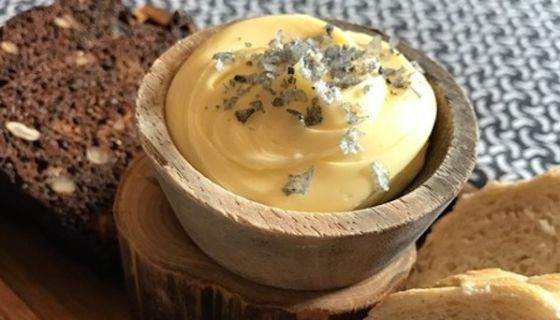Forty eight hours in Tallinn, Estonia, to speak at Sauce gastronomic conference made me think of my Russian Jewish grandfather a great deal. At breakfast in the Telegraaf hotel I made a point of eating smoked herring, slices of boiled egg and thick pieces of dark rye bread, which I washed down with cups of black tea and honey. On the Sunday morning I visited the Estonian Bread Day, an annual event that takes place in the Estonian Open Air Museum with displays of onions from western Estonia, honeys, piles of smoked fish and flour producers that culminated in a blessing of the bread in the wooden chapel. And at both lunch and dinner I found it very difficult not to gorge myself on the black bread and butter that was routinely served.
Certainly, that was one of the strongest impressions after I had sat down at Cru restaurant on Vru street at about 2.45 on a Sunday afternoon. I had been lured in by the restaurant’s garden and by the fact that a sign outside proclaimed that the restaurant’s chef is Dmitri Haljukov, who had represented Estonia in the Bocuse d’Or Chef Championship in 2015 in Lyons and had finished a most respectable 14th.
I walked in. It is one of the hangovers from the Soviet era that most Estonian restaurants, even the more enterprising ones, are open all day at weekends, but because the sun was shining I walked into an empty restaurant. I was seated on one side of the main room looking out on to the street and across from a copy of an enchanting painting of a cafe scene, the original of which hangs in the Tallinna Kunstihoone, the local art gallery.
On the other side, looking out on to the street, was perhaps a more typical scene: signs for an exhibition space given over to medieval torture equipment. By the entrance stood two youths, one on his iPhone, both dressed in jester’s outfits, and a grey-haired man wearing a long cloak, carrying a menu and bowing deeply towards all the women who walked by.
I was soon confronted by their menu and a wooden tray of bread and butter. There were two sorts, both home made, a white bread and a black one containing hazelnuts, pieces of apricot and, I was warned, possibly the vestiges of an apricot stone. It was absolutely delicious and I was on to my second piece before I even opened the menu.
This was resolutely short and attractive. I chose two first courses, a rich crab soup – thick, creamy and poured from a small jug on to a bowl of mussels, diced kohlrabi, salmon and pasta shells – and something described as salted vendace (below) with sour cream from Saaremaa, the largest of the islands in the Baltic south west of Tallinn. This was a complicated dish that involved the eggs of the vendace fish served on top of slices of potato and topped with thin black chips from potatoes cooked in an open hearth. As inspiring was the dessert, an individual ‘baked Alaska’ served under its own plastic top.

I returned that evening and was confronted by a different bread basket: the same black bread served with the same health warning but on this occasion the white bread had been replaced by some delicious wholemeal rolls. This time I ventured into their wine list and chose a bottle of La Torre 2010 Brunello di Montalcino for a very reasonable €75.

With this I ate a particularly good first course of a salad of smoked eel topped with fresh peas, radishes, a confited egg yolk, slices of apple and black breadcrumbs. My main course, calves liver with mashed potatoes, was let down by its style of presentation as the bowl it was served in allowed none of the otherwise well-executed ingredients to speak for themselves, a fault that could easily be rectified by serving the same ingredients on a plate. The ensuing dessert, described as a Polar Summer, a cold éclair with unripe strawberries and a rhubarb sauce, left me with a smile on my face and a bill for €113 without service.
Leib restaurant takes its bread so seriously that it even takes its name from the Estonian word for black bread. This modern restaurant, now home to chef Janno Lepik and sommelier Kristjan Peäske, was once a private house and boasts a less-than-obvious entrance off Uus street; a large garden in which there is a bust of Sir Sean Connery; and two or three floors that topple down from the top floor to the main street and encompass a wall on which a massive moose head is firmly attached.
Peäske’s involvement in Leib is such that the opening page of their four-page menu begins with a varied drinks selection before opening on to a left-hand page offering starters, a clear chanterelle soup and five main courses. The right-hand page lists the desserts and above that five different combinations of a single dish with a different locally brewed beer.

Of the starters, the whitefish roe with marinated potatoes and sour cream was the most distinctive while the soft goat’s cheese salad with tomatoes from Intsu was the prettiest. The quail served with a warm potato salad was good but over salty. Our dessert, however, described as dried egg yolk with cherry cream and yoghurt sorbet, showed just what Lepik and his team are capable of: a round of frozen egg white enclosing a centre of a cherry sorbet topped with grated egg yolk. Absolutely delicious!

Cru Viru 8, Tallinn; tel +372 614 0085. Monday – Sunday, 11 am to 11 pm.
Leib Uus 31, Tallinn; tel +372 611 9026. Monday – Friday, 12 am to 3 pm, 6 pm to 11 pm, Saturday and Sunday 12 am to 11 pm.














